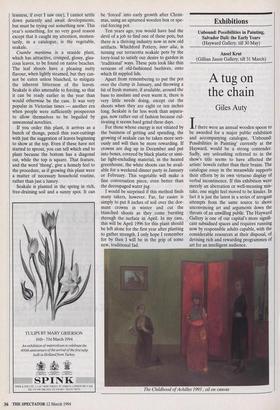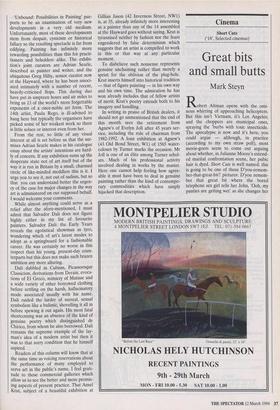Exhibitions
Unbound: Possibilities in Painting, Salvador Dali: the Early Years (Hayward Gallery, till 30 May) Ansel Krut
(Gillian Jason Gallery, till 31 March)
A tug on the chain
Giles Auty
If there were an annual wooden spoon to be awarded for a major public exhibition and accompanying catalogue, 'Unbound: Possibilities in Painting' currently at the Hayward, would be a strong contender. Sadly, any unleashing referred to in the show's title seems to have affected the artists' bowels rather than their brains. The catalogue essay in the meanwhile supports their efforts by its own virtuoso display of verbal incontinence. If this exhibition were merely an aberration or well-meaning mis- take, one might feel moved to be kinder. In fact it is just the latest in a series of arrogant attempts from the same source to shove unconvincing art and arguments down the throats of an unwilling public. The Hayward Gallery is one of our capital's more signifi cant subsidised spaces and requires running now by responsible adults capable, with the considerable resources at their disposal, of devising rich and rewarding programmes of art for an intelligent audience.
The Childhood of Achilles 1993 , oil on canvas `Unbound: Possibilities in Painting' pur- ports to be an examination of very new developments in a very old medium. Unfortunately, most of these developments stem from despair, cynicism or historical fallacy so the resulting spectacle is far from edifying. Painting has infinitely more rewarding possibilities than this for practi- tioners and beholders alike. The exhibi- tion's joint curators are Adrian Searle, described as painter and writer, and the ubiquitous Greg Hilty, senior curator now at the Hayward, where he has been associ- ated intimately with a number of recent, heavily-criticised flops. This daring duo have put in umpteen hours and air miles to bring us 13 of the world's more forgettable exponents of a once-noble art form. The 14th artist, Paula Rego, is ill-advised to hang here but typically the organisers have picked some of her weakest work so there is little solace or interest even from her.
From the rest, so little of any visual interest at all is set before us that the sur- mises Adrian Searle makes in his catalogue essay about the artists' intentions are hard- ly of concern. If any exhibition sums up the desperate state not of art itself but of the way it is run in Britain by a small, charmed circle of like-minded meddlers this is it. I urge you to see it, not out of sadism, but so that you can understand better the urgen- cy of the case for major changes in the way art is administered on our supposed behalf. I would welcome your comments.
While almost anything could serve as a relief after the afore-mentioned, I must admit that Salvador Dali does not figure highly either in my list of favourite painters. Salvador Dali: the Early Years reveals the egotistical showman as tyro, wondering which of art's latest modes to adopt as a springboard for a fashionable career. He was certainly no worse in this respect than his young, present-day coun- terparts but this does not make such brazen ambition any more alluring. Dali dabbled in Cubism, Picassoesque Classicism, derivations from Derain, evoca- tions of El Greco, mimicry of Matisse and a wide variety of other borrowed clothing before settling on the harsh, hallucinatory mode associated usually with his name. Dali raided the larder of surreal, sexual symbolism like a bulimic, shovelling it all in before spewing it out again. His most fatal shortcoming was an absence of the kind of genuine poetry which distinguished de Chirico, from whom he also borrowed. Dali remains the supreme example of the lay- man's idea of a modern artist but then it was to that sorry condition that he himself aspired.
Readers of this column will know that at the same time as voicing reservations about the performance of many employed to serve art in the public's name, I feel grati- tude to those commercial galleries which allow us to see the better and more promis- ing aspects of present practice. That Ansel Krut, subject of a beautiful exhibition at Gillian Jason (42 Inverness Street, NW1) is, at 35, already infinitely more interesting as a painter than any of the 14 assembled at the Hayward goes without saying. Krut is tyrannised neither by fashion nor the fears engendered by false determinism which suggests that an artist is compelled to work in this or that way at any particular moment.
To disbelieve such nonsense represents genuine unchaining rather than merely a sprint for the oblivion of the plug-hole. Krut inserts himself into historical tradition — that of figure painting — in his own way and his own time. The admiration he has won already includes that of fellow artists of merit. Krut's poetry extends both to his imagery and handling.
In writing in praise of British dealers, it should not go unmentioned that the end of this month sees the retirement from Agnew's of Evelyn Joll after 45 years ser- vice, including the role of chairman from 1982-1992. A loan exhibition at Agnew's (43 Old Bond Street, W1) of 1565 water- colours by Turner marks the occasion. Mr Joll is one of an elite among Turner schol- ars. Much of his professional activity involved dealing in works by the master. Here one cannot help feeling how agree- able it must have been to deal in genuine painting rather than the kind of contempo- rary commodities which have simply hijacked that description.



















































 Previous page
Previous page